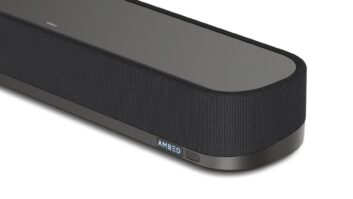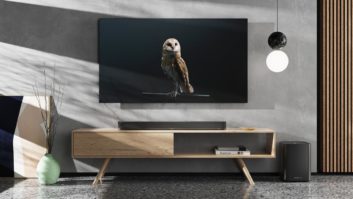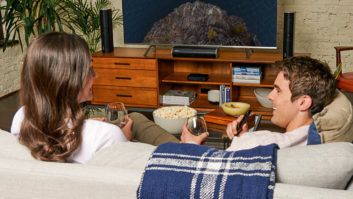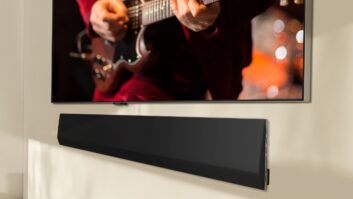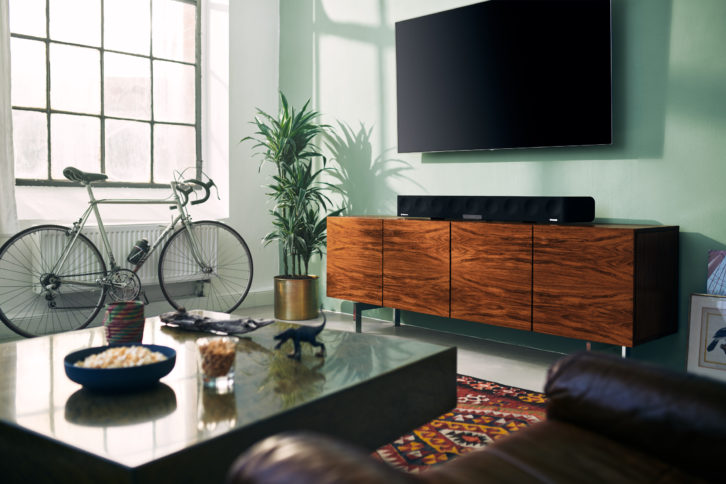
There are essentially three kinds of soundbar customers: the person looking to improve the TV’s anemic audio; the person wanting better sound but not the complexity and components of an actual surround system; and the person who would love a true surround system but can’t install one for some reason.
It is this second and especially third group to whom the new Sennheiser SB01 AMBEO soundbar will primarily appeal. This bar is designed as a true surround system replacement in one chassis. No wireless rear speakers, no separate subwoofer; just a lot of drivers, amplification, and some sonic magic to create a fully immersive surround experience from a single bar.
I know. I’ve heard that promise before, too.
But I first experienced the AMBEO at the Consumer Electronics Show in 2018 where Sennheiser was demonstrating it in a packed room that had a constant line to get in. They promised true Dolby Atmos immersive audio from this single bar, and I remember them doing some A/B comparisons between the bar and a true 8.2-channel surround system said to cost in excess of $50,000. I left feeling the bar had shockingly held its own, and I immediately requested a review sample.
Unfortunately, the bar was not ready for production. However, the bar made a return at this year’s CES where it was officially launched as Sennheiser’s first foray into the home entertainment speaker category. “Developed,” said Stephane Hareau, Sennheiser’s global head of consumer products, “with the ambition to create one of the best soundbars on the market.”
It is not any hyperbole to say that the AMBEO bar is unlike any other bar you’ve ever seen. First off, it’s huge. In fact, let’s just get this out of the way up front — the AMBEO is so big that its size might be a deal killer for some right off the bat. At just shy of 50 inches, it’s wider than a 55-inch TV, and stands nearly half-a-foot tall, making it difficult to sit in front of a TV, and it sticks off the wall almost 8 inches if mounted. (And, surprisingly for such a premium-priced bar, the AMBEO does not include a wall bracket, rather Sennheiser offers one separately.)
Also, you know how some soundbars are so flimsy and light you wonder how there could be anything of value inside of them? Yeah. Not this. Pick this up (#ProTip: Don’t lift with your back!) and you’ll know it’s filled with real drivers and serious construction. At nearly 41 pounds, this weighs just slightly less than my 7×150-watt Marantz MM8807 theater amplifier!
That why I started calling it MOAB – Mother of All Bars.
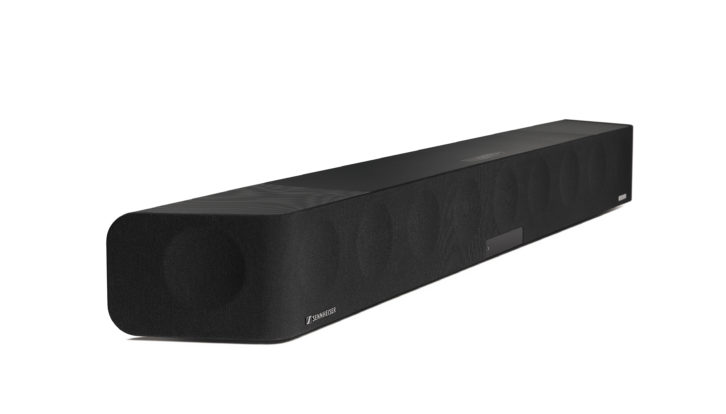
Any doubt that Sennheiser expects this bar to have worldwide acceptance is erased when you see the included Quick Setup Guide, which is in 29 languages. This is the UN of setup guides and a record as far as I know. The far more comprehensive 55-page instruction manual (English only) is available for download.
The bar has a nice brushed aluminum exterior, with fronts and sides covered by a large grille, and perforated metal grille protecting the upfiring drivers on top. The grille is just transparent enough for you to see the nine front-mounted and two side-firing drivers, part of the bar’s 13-speaker array. There are some top-mounted buttons for basic control and a small but effective OLED display in front.
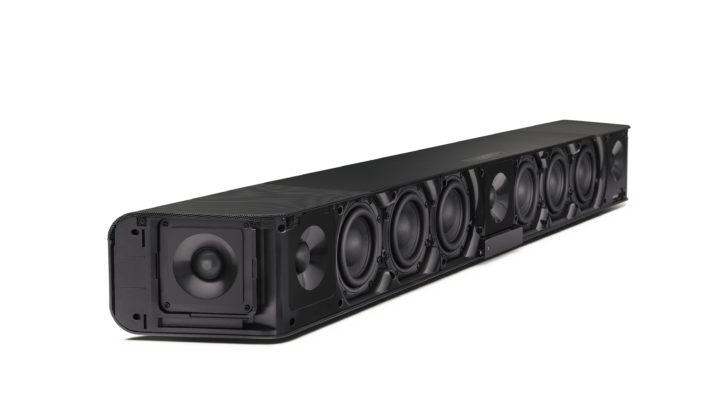
All connections are actually made on the bottom of the bar, but they are in a recess so they aren’t impacted if the bar sits on a shelf. One nice bonus to the wiring being on the bottom is it makes it much easier to check, confirm, or add connections when the bar is wall mounted. The AMBEO has three 4K HDR (including Dolby Vision) capable HDMI inputs, along with Toslink optical digital, and RCA analog audio. The HDMI output features eARC, and an RCA pre-out is available for adding a wired subwoofer. Streaming is provided in the form of Google Chromecast and Bluetooth, with the bar connecting to the network via Ethernet or Wi-Fi.
Sennheiser offers pretty specific recommendations for placing the AMBEO. First, the bar should be centered between the side walls, with the optimum distance between the bar and the side walls being between 1-5 meters. Second, you shouldn’t have any object that blocks or absorbs the sound between the bar and the side walls and ceiling of the room. Third, the bar should be placed at least 10 cm below the TV, and between 1-5 meters from the ceiling, which should be flat, not sloped. Finally, the seating distance should be at least 2 meters from the bar.
Of course, most rooms likely won’t conform to this ideal, and I installed it in my bedroom, which I would score a 5 out of 10 for an “ideal” AMBEO-shaped room. Meaning, I think results could be even better than what I experienced.
Prior to using the bar for the first time, you are prompted to run the room calibration using the included microphone and stand. This is a pretty straight-forward process that involves connecting the mic to the bar’s front input, placing the mic at ear height, and running a series of test tones; a process that takes about five minutes and that is very effective.

Basic control is performed via the included IR remote, that, sadly, offers no backlighting. (It’s such a simple thing that makes such a difference.) The remote does give discrete access to the six different sound modes: Movie, Music, News, Sports, Neutral, and Night. Accessing additional features and configuration options is done via either the iOS or Android Sennheiser Smart Control app. With the app you can re-label inputs, adjust the brightness settings of the front panel display, tweak the acoustical settings, and more. I used the app quite a bit, but found it a bit finicky for connecting, often not “seeing” the bar when opening the app.
Sonically, the AMBEO bar is just flat out amazing. I know the specs say it will play down to 30 Hz, but actually hearing those six 4-inch long-throw bass drivers produce bass that is that startlingly deep and tight is another thing. One of my favorite bass test tracks is The Crystal Method’s “High Roller,” and the AMBEO delivered the big bass notes without any strain.
Music is great for checking if the processing is coloring or affecting the signal, and I felt the AMBEO’s width and height drivers coupled with the DSP and room correction produced a front image that is stable and uncolored while providing a ton of width and space. You can easily toggle the AMBEO effects on/off and I never once felt it sounded better off. Ditto with the effects of the room correction; when defeated, the soundstage just collapsed and felt thin.
Surround performance was equally impressive, with the bar breathing tons of life into Dolby Digital and DTS tracks by upmixing audio to deliver a far more immersive experience. I ran a couple of favorite scenes from my Kaleidescape through the bar, and I was continually amazed at how much height and width the bar produced. In U-571, depth charge splashes clearly came high up on the front wall, with explosions rattling overhead all around me. The opening scene from Master and Commander has the sounds of sails clearly flapping overhead along with creaks and groans from the ships and footsteps of people walking around. The “refueling the plane” scene from World War Z filled the room with a rainstorm and echoes far more impressively than a regular 5.1-channel system could do.
As good as the bar does with upmixing, it really shines when it comes to playing back true Dolby Atmos and DTS:X encoded content. And I also loved that that front OLED display clearly indicates Dolby Atmos or DTS:X, letting users know they are getting what they paid for. Pick your favorite demo scene and the AMBEO delivers all the excitement you’ve come to expect. Planes and helicopters soar overhead, explosions and fireworks go off all around you, vehicles race along the far sides of the room; AMBEO delivers it all.
Related: John Sciacca reviews the Sony HT-Z9F Dolby Atmos/DTS:X soundbar.
The “It’s just an illusion” scene from Spider Man: Far From Home uses the height speakers to great effect with dialog that comes from all around overhead, and the AMBEO nails it. Another great demo is “The First Challenge” from Ready Player One. The scene opens with a firework that streaks up and explodes directly overhead, and is filled with cars driving, crashing, and mayhem swirling by and around in every direction. About the only possible room for improvement would be adding a sub or two to deliver truly subsonic bass performance, but most users likely won’t miss it.
For many, home theater’s Holy Grail is a single device that can deliver a truly immersive listening experience. Without a doubt, the AMBEO comes closest to replicating a discrete surround system experience than anything else I experienced. There were many moments where sounds were clearly localizable in points all around the room and overhead. And this in a room that was nowhere close to the ideal. I’ve reviewed many soundbars; the AMBEO stands head-and-shoulders at the top of the pack, and I can’t recommend it highly enough.
877-736-6434 – SENNHEISER.COM
Kudos: Incredible AMBEO immersive technology; serious bass without a sub; room calibration
Concerns: It’s huge; Sennheiser app a bit glitchy; no remote backlighting
Product Specs
- 5.1.4-channels featuring 13 speaker drivers
- Includes (6) 4-inch mid-bass drivers, (5) 1-inch tweeters, (2) 3.5-inch broadband top-firing speakers; powered by 250-watts (RMS), 500-watts (peak)
- 30 Hz to 20 kHz frequency response (–3 dB)
- Decodes Dolby Atmos (TrueHD), DTS:X, and MPEG-H
- GoogleCast and Bluetooth
- Wi-Fi 2.4GHz/5 GHz 801.11 a/b/g/n/ac
- Inputs: 3 HDMI 2.0a/HDCP 2.2 (Dolby Vision pass-through), RCA analog audio, Toslink optical digital, Ethernet RJ45, USB Type-A (service only), 2.5 mm mini-jack for calibration microphone (front); Outputs: HDMI 2.0a/eARC (HDMI 2.1), RCA subwoofer; detachable AC power
- Wall mounting requires SB01-WM (not included)
Dimensions: 49 13/16 x 5 5/16 x 6 3/4-inches (W x H x D); 40 pounds, 13 ounces
